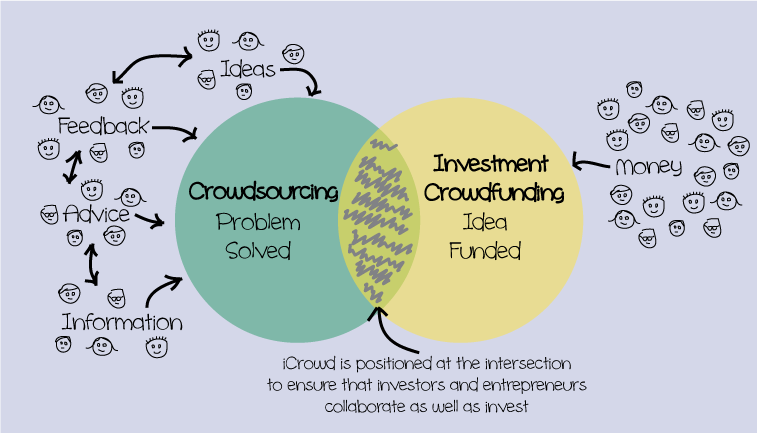Crowdfunding is the in thing
 Small budding entrepreneurial enterprises need not wait any longer for want of the endless procedures for raising funds any longer. All that is required is a good, workable idea and there are people known and unknown who are ready to back a venture. This practice is called crowdfunding. One can raise money from a large number of people, usually through social media – via the Internet.
Small budding entrepreneurial enterprises need not wait any longer for want of the endless procedures for raising funds any longer. All that is required is a good, workable idea and there are people known and unknown who are ready to back a venture. This practice is called crowdfunding. One can raise money from a large number of people, usually through social media – via the Internet.
In India, filmmaker Srinivas Sunderrajan raised Rs. 5,26,000 from 79 supporters for the post-production of his film Greater Elephant. Student filmmakers Aniket Dasgupta and Swathy Sethumadhavan raised Rs. 1,01,000 from 49 supporters for the pre-production of their documentary The Other Way on the indie film movement in India while 21-year-old Vanshaj Kapur raised Rs. 1,15,000 from 32 contributors for completing his film through Wishberry. Vasudha Sharma’s raised Rs. 5,65,000 from 119 supporters for her music album. So, things are changing fast. There are people out there who would like to support a good idea, a good movement, a good workable business.
Traditionally, if you want to raise capital to start a business, you need to work out your business plan, for which you need to knock on doors of market research companies and consultants, prepare prototypes, and then shop your idea around to a limited pool or wealthy individuals or institutions. These funding sources included banks, angel investors, venture capital firms, non banking finance companies NBFCs were just few options to whom you would go for funding. And, you would experience frustration losing time, energy and money to get the funds required to start your enterprise.
But, with crowdfunding you can think of this fundraising approach as a channel tapping into wide audience and investors all over the world. Crowdfunding platforms give you, a single platform to build, showcase, and share your resources. This approach noticeably outsmarts the traditional model of fundraising. In the older method where you would spend months examining your personal network, selecting potential investors, and spending your own time and money to get in front of them, in crowdfunding, it’s much easier for you to get your opportunity in front of more interested parties and give them more ways to help grow your business. It’s worth a mention here that there are a plethora of crowdfunding platforms available today. There are industry-specific general platform; so you can go to one in which your startup fits the best. This will also enable investors who are willing to invest in specific sector. This will also enable you to get some tips and advises from other entrepreneurs who have used crowdfunding.
 From tapping into a wider investor pool by enjoying more flexible fundraising options, there are some other benefits to crowdfunding over traditional methods.
From tapping into a wider investor pool by enjoying more flexible fundraising options, there are some other benefits to crowdfunding over traditional methods.
Wider Reach: Through crowdfunding, you have access to thousands of accredited investors whom you can see, interact with, and share your fundraising campaign. Through this platform, you can present the precious process of looking at your business in a wholesome manner; its history, grip in terms of workability, offerings, market, value proposition, and much more. All this can be presented in a polished easily digestible manner.
Sales & Marketing: Right from launch, you can share and promote your business and ideas through social media, email, and cloud computing and other online marketing tactics. As your marketing campaign progresses, your business gets more noticed allowing you to grow faster. Also, your concept gets validation from the masses. As potential investors begin to express interest and ask questions, you can swiftly see if there’s something missing that would make them more likely to buy in.
Effective impact: One of the best things about online crowdfunding is its capacity to centralize and streamline your fundraising efforts by just building a single, comprehensive profile to which you can pull all your prospective and potential investors. You need not follow each of them individually. This process eliminates duplication of printing documents, compiling binders, and manually updating each one. You can present everything online in a much more accessible format, leaving you with more time to run your business instead of fundraising.
There are three general categories crowdfunding. They are Equity, Donation, and Debt.
Equity-based: Equity–based crowdfunding is asking a crowd to donate to your business or project in exchange for equity. Equity crowdfunding is a method that enables broad groups of investors to fund startup companies and small businesses. Investors give money to a business and receive ownership of a small piece of that business. If the business succeeds, then its value goes up; just like the value of a share in that business. Coverage of equity crowdfunding indicates that its potential is greatest with startup businesses that are seeking smaller investments to achieve establishment, while follow-on funding required for rapid growth. The funds might come from many sources.
Donation-based: Donation-based crowd-funding is a way to source money for a project by asking a large number of donors to donate small amounts to it. In return, the donors may receive token rewards. The tokens might be pre-sale item, some small gifts. The donors contribute their monies for the idea or concepts of the business. Sometimes donation crowdfunding is also referred to as rewards crowdfunding. Donation-based crowdfunding can also be used in an effort to raise funds for charitable causes. Because this type of crowd funding is based on donations, funders do not obtain any ownership or rights to the project, nor do they become creditors to the project.
Debt-based: This type of crowdfunding is asking a crowd to provide funds to your business in exchange for financial return and/or interest at a future date. In the U.S. debt-based crowd funding from non-banks became more prominent as a form of crowd funding in 2012, with the launch of the lending clubs which use technology to operate a credit marketplace at a lower cost than traditional bank loan programs, passing the savings on to borrowers in the form of lower rates and to investors in the form of solid returns. In U.S lending clubs have distributed more than US$500 million in loans via its website by April 2012. Prospective borrowers of the Lending Club first submit their requirements, and are then matched with pools of investors who are willing to accept the credit terms. Platforms such as the Lending Club gained popularity, as banks increased interest rates or reduced their level of lending activity.
Crowdfunding is useful for a variety of opportunities; fundraising for disaster-relief, creative projects, creating a salable product, or creating a start-up. Crowdfunding platforms allow you to market your project, generate interest, and receive funds. Because it works on social media platform it can provide useful feedback about a project. Once your business idea and concept gets a support, there is no looking back. Crowdfunding is not limited to certain kind of project, there is no discrimination, only great ideas. The more creativity and fun you have, the more likely you’ll get funded.
There is also a bad side to it. Your project can be copied by potential copycats. There are some delays here also. It just doesn’t happen in jiffy. Crowdfunding platforms often limit the amount of funds you expect to receive. Crowdfunding regulations and taxation can be difficult to work with.
Last piece of advice to all those young budding entrepreneurs is that you are lucky to raise a large amount of money from crowd but that does not give you assurance that your startup will run successfully; you have to still run your business by putting in hard efforts on daily basis. There is still no substitute to working hard. And, the future of crowdfunding largely depends on how successfully startups use it to build their companies and repay the investors. The startups need creative and workable ideas and of course smart strategies. I wish to list few leading crowd-funding platforms for the reader’s choice.
RocketHub: Initially launched with the arts in mind, it expanded to include science, education, business and social good projects. It gained footing in the sciences with its annual SciFund Challenge, an online effort to fund science projects. It also launched a partnership with A&E Networks through which some select projects will be chosen to receive extra support from the joint initiative.
Peerbackers: Recognized as one of the top crowdfunding websites in the industry, peerbackers, focuses on funding entrepreneurs and innovators. The platform has hosted thousands of creative, civic and entrepreneurial projects from around the world. Recently it has extended its arm to young entrepreneurs who are aged 13 to 17 through partnerships with student organizations.
MicroVentures: Calls itself an “investment bank for startups.” It carries out due diligence on startups and then, if approved, helps raise capital from angel investors via its SEC-approved online platform, giving angel investors the ability to invest small amounts of capital to crowdfund a startup.
 Crowdfunding in India is still in its nascent stages. However, the potential is incredibly high for Indian crowdfunding; 50% nation is youthful, educated, and restless with big dreams. There are lakhs of dynamic and fascinating independent projects breaking boundaries. The Securities and Exchange Board of India has proposed new norms for ‘crowdfunding’ or collection funds through web-based platforms and social networking sites; a move that would help start-up companies raise capital and also check misuse of such avenues. Under the proposed norms, crowdfunding platforms can be provided by only SEBI-registered entities, while companies can raise up to Rs.10 crore in a year through this route. Given the high-level of risks associated with this new way of fund-raising activity, SEBI has also proposed that only ‘accredited investors’ be allowed to participate in crowdfunding activities.
Crowdfunding in India is still in its nascent stages. However, the potential is incredibly high for Indian crowdfunding; 50% nation is youthful, educated, and restless with big dreams. There are lakhs of dynamic and fascinating independent projects breaking boundaries. The Securities and Exchange Board of India has proposed new norms for ‘crowdfunding’ or collection funds through web-based platforms and social networking sites; a move that would help start-up companies raise capital and also check misuse of such avenues. Under the proposed norms, crowdfunding platforms can be provided by only SEBI-registered entities, while companies can raise up to Rs.10 crore in a year through this route. Given the high-level of risks associated with this new way of fund-raising activity, SEBI has also proposed that only ‘accredited investors’ be allowed to participate in crowdfunding activities.













































